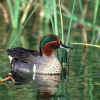|
|
Description
There are three subspecies of this little duck, the European (Common) Teal (A. c. crecca), Aleutian Teal (A. c. nimia) and the American Green-winged Teal (A. c. carolinensis). The major differences in the subspecies, can be seen in the drakes. American drakes have a vertical white band on the side of it's breast, whereas the European drakes have a horizontal white band above the wings. The drakes of the European subspecies also have a more defined border to the green patch on the face. The Aleutian is nearly identical to the European, but larger and found only on the Aleutian Islands and is not migratory. All the females are very similar to one another. With this care sheet, I will concentrate on the American subspecies, but I'm sure the information would apply to the others as far as captive care.
In North America, the Green-wing Teal is the smallest native duck. The teal breeds across much of Canada and the northern States, and winters from the U.S. to Central America. It is still very common throughout much of it's range and are popular with duck hunters.
|
|
Breeding
The green-wing is one of the easiest ducks to breed in captivity. The breeding season begins in early May and the hens look to build nests in stands of thick grass or other vegetation, but may also accept boxes. They do not require a large aviary, as long as it is well planted. The clutch sizes range from 6 to 12 cream colored eggs and are incubated for about 23 days. The hens can be allowed to hatch and rear their own young, but due to their small size, the aviary walls need to be covered or made of small wire to prevent escape.
|
|
General Comments
The young grow quickly and are able to fly in about a month and a half. The immature resemble the hen, but their under parts are spotted brown. Males will receive their adult plumage and will breed their first year.
One of my all time favorite ducks, I recommend these to any beginner to this hobby. The males are very ornamental and are a beautiful addition to a small pond or aviary. They are docile and sometimes bullied by larger species, so keep with species that are not very aggressive. Since they are a native migratory bird, permits are needed to keep this species and are available from the U.S. Fish and Wildlife Service.
They are winter hardy and will survive very cold weather with a good shelter. A pond is not necessary, but provide a tub of clean water that is large enough for the ducks to bathe and breed.
|
|
Place Mouse over Pictures to Enlarge

Green wing Drake

Green wing Hen

Green wing Pair
How
to Order
|